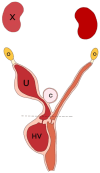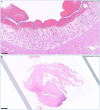Diagnosis and surgical treatment of obstructed hemivagina and ipsilateral renal anomaly in a dog: a case report
- PMID: 39811148
- PMCID: PMC11729922
- DOI: 10.3389/fvets.2024.1488107
Diagnosis and surgical treatment of obstructed hemivagina and ipsilateral renal anomaly in a dog: a case report
Abstract
Obstructed hemivagina and ipsilateral renal agenesis (OHVIRA), also called Herlyn-Werner-Wunderlich syndrome, is an extremely rare Müllerian duct anomaly accompanied by Wolffian duct anomalies. A 10-year-old intact female Yorkshire Terrier weighing 3.35 kg was presented with anorexia, depression, vomiting, and abdominal pain. Radiography, ultrasonography, and computed tomography revealed uterine didelphys, obstructed hemivagina, a cystic structure around the right uterus, and right renal agenesis, leading to the diagnosis of OHVIRA syndrome. An ovariohysterectomy and decompression of the obstructed right hemivagina were performed, and the cystic structure near the right uterine horn was removed by en bloc resection, along with the right uterus and ovary. After the surgical intervention, the patient's symptoms including abdominal pain, anorexia, and depression were immediately resolved. The patient was followed up for 1 month postoperatively with ultrasonography at 2-week intervals, which revealed the progression of mild fluid retention in the right hemivagina. However, no additional urogenital findings were identified, and the patient continued to exhibit no overt clinical symptoms. This case report describes the diagnosis and surgical treatment of the first documented case of OHVIRA syndrome in an animal. Unlike in human medicine, where vaginal septectomy is performed to prevent dilatation of the obstructed hemivagina and thereby resolve clinical symptoms, performing ovariohysterectomy combined with fluid aspiration from the obstructed hemivagina showed a favorable postoperative prognosis in the dog.
Keywords: Gartner duct cyst; Herlyn–Werner–Wunderlich syndrome; OHVIRA; dog; unilateral renal agenesis.
Copyright © 2024 Choo, Cho, Cha, Kim and Kim.
Conflict of interest statement
The authors declare that the research was conducted in the absence of any commercial or financial relationships that could be construed as a potential conflict of interest.
Figures




Similar articles
-
Prenatal Diagnosis of Fetal Obstructed Hemivagina and Ipsilateral Renal Agenesis (OHVIRA) Syndrome.Medicina (Kaunas). 2023 Apr 4;59(4):703. doi: 10.3390/medicina59040703. Medicina (Kaunas). 2023. PMID: 37109661 Free PMC article.
-
[Müllerian anomalies. Obstructed hemivagina and ipsilateral renal anomaly syndrome (OHVIRA)].Cir Cir. 2014 Jul-Aug;82(4):460-71. Cir Cir. 2014. PMID: 25167360 Review. Spanish.
-
Aqueous vaginal contrast and scheduled hematocolpos with magnetic resonance imaging to delineate complex müllerian anomalies.Fertil Steril. 2022 Jan;117(1):221-223. doi: 10.1016/j.fertnstert.2021.08.041. Epub 2021 Sep 20. Fertil Steril. 2022. PMID: 34548169
-
A rare case of OHVIRA (obstructed hemivagina and ipsilateral renal anomaly) syndrome: Case report.Radiol Case Rep. 2024 Jun 15;19(9):3667-3671. doi: 10.1016/j.radcr.2024.05.076. eCollection 2024 Sep. Radiol Case Rep. 2024. PMID: 38983302 Free PMC article.
-
[Uterus Didelphys, obstructed hemivagina and ipsilateral renal agenesis as a presentation of a case of the Herlyn-Wemer-Wünderlich syndrome. Literature review].Ginecol Obstet Mex. 2013 Oct;81(10):616-20. Ginecol Obstet Mex. 2013. PMID: 24483046 Review. Spanish.
References
-
- Ullah H, Slehria AUR, Mahmood R, Akbar J. Herlyn–Werner–Wunderlich syndrome-role of imaging in timely and correct diagnosis. Pak Armed Forces Med J. (2021) 71:364–6. doi: 10.51253/pafmj.v71i1.3740 - DOI
-
- Kudela G, Wiernik A, Drosdzol-Cop A, Machnikowska-Sokołowska M, Gawlik A, Hyla-Klekot L, et al. . Multiple variants of obstructed hemivagina and ipsilateral renal anomaly (OHVIRA) syndrome—one clinical center case series and the systematic review of 734 cases. J Pediatr Urol. (2021) 17:653.e1–9. doi: 10.1016/j.jpurol.2021.06.023 - DOI - PubMed
Publication types
LinkOut - more resources
Full Text Sources
Research Materials

